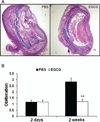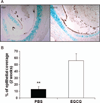Green tea epigallo-catechin-galleate ameliorates the development of obliterative airway disease
- PMID: 21787235
- PMCID: PMC4372092
- DOI: 10.3109/01902148.2011.584359
Green tea epigallo-catechin-galleate ameliorates the development of obliterative airway disease
Abstract
Lung transplantation has the worst outcome compared to all solid organ transplants due to chronic rejection known as obliterative bronchiolitis (OB). Pathogenesis of OB is a complex interplay of alloimmune-dependent and -independent factors, which leads to the development of inflammation, fibrosis, and airway obliteration that have been resistant to therapy. The alloimmune-independent inflammatory pathway has been the recent focus in the pathogenesis of rejection, suggesting that targeting this may offer therapeutic benefits. As a potent anti-inflammatory agent, epigallo-catechin-galleate (EGCG), a green tea catechin, has been very effective in ameliorating inflammation in a variety of diseases, providing the rationale for its use in this study in a murine heterotopic tracheal allograft model of OB. Mice treated with EGCG had reduced inflammation, with significantly less neutrophil and macrophage infiltration and significantly reduced fibrosis. On further investigation into the mechanisms, inflammatory cytokines keratinocyte (KC), interleukin-17 (IL-17), and tumor necrosis factor-α (TNF-α), involved in neutrophil recruitment, were reduced in the EGCG-treated mice. In addition, monocyte chemokine monocyte chemoattractant protein-1 (MCP-1) was significantly reduced by EGCG treatment. Antifibrotic cytokine interferon-γ-inducible protein-10 (IP-10) was increased and profibrotic cytokine transforming growth factor-β (TGF-β) was reduced, further characterizing the antifibrotic effects of EGCG. These findings suggest that EGCG has great potential in ameliorating the development of obliterative airway disease.
Conflict of interest statement
Figures






Similar articles
-
[Establishment of obliterative bronchiolitis in allo-trachea transplant model of rat and detection of its pathogenesis preliminarily].Zhonghua Wai Ke Za Zhi. 2007 Feb 15;45(4):262-6. Zhonghua Wai Ke Za Zhi. 2007. PMID: 17502025 Chinese.
-
Transforming growth factor beta (TGF-beta) and obliterative bronchiolitis following pulmonary transplantation.J Heart Lung Transplant. 1999 Sep;18(9):828-37. doi: 10.1016/s1053-2498(99)00047-9. J Heart Lung Transplant. 1999. PMID: 10528744
-
Interleukin-18: A Novel Participant in the Occurrence, Development, and Drug Therapy of Obliterative Bronchiolitis Postlung Transplantation.Dis Markers. 2021 Jul 27;2021:5586312. doi: 10.1155/2021/5586312. eCollection 2021. Dis Markers. 2021. PMID: 34367377 Free PMC article.
-
Potential benefits of green tea polyphenol EGCG in the prevention and treatment of vascular inflammation in rheumatoid arthritis.Life Sci. 2013 Sep 3;93(8):307-12. doi: 10.1016/j.lfs.2013.07.006. Epub 2013 Jul 19. Life Sci. 2013. PMID: 23871988 Free PMC article. Review.
-
Human and murine obliterative bronchiolitis in transplant.Proc Am Thorac Soc. 2007 Jan;4(1):37-43. doi: 10.1513/pats.200605-107JG. Proc Am Thorac Soc. 2007. PMID: 17202290 Free PMC article. Review.
Cited by
-
Relationships between black tea consumption and key health indicators in the world: an ecological study.BMJ Open. 2012 Nov 8;2(6):e000648. doi: 10.1136/bmjopen-2011-000648. Print 2012. BMJ Open. 2012. PMID: 23138107 Free PMC article.
-
The medicinal value of tea drinking in the management of COVID-19.Heliyon. 2023 Jan;9(1):e12968. doi: 10.1016/j.heliyon.2023.e12968. Epub 2023 Jan 12. Heliyon. 2023. PMID: 36647394 Free PMC article. Review.
-
Inhaled tea polyphenol-loaded nanoparticles coated with platelet membranes largely attenuate asthmatic inflammation.Respir Res. 2024 Aug 17;25(1):311. doi: 10.1186/s12931-024-02947-3. Respir Res. 2024. PMID: 39154188 Free PMC article.
-
Bone marrow-derived multipotent stromal cells attenuate inflammation in obliterative airway disease in mouse tracheal allografts.Stem Cells Int. 2014;2014:468927. doi: 10.1155/2014/468927. Epub 2014 Sep 10. Stem Cells Int. 2014. PMID: 25295064 Free PMC article.
-
Divergent Function of Programmed Death-Ligand 1 in Donor Tissue versus Recipient Immune System in a Murine Model of Bronchiolitis Obliterans.Am J Pathol. 2017 Jun;187(6):1368-1379. doi: 10.1016/j.ajpath.2017.02.007. Epub 2017 Apr 17. Am J Pathol. 2017. PMID: 28427861 Free PMC article.
References
-
- Christie JD, Edwards LB, Aurora P, Dobbels F, Kirk R, Rahmel AO, Taylor DO, Kucheryavaya AY, Hertz MI. Registry of the International Society for Heart and Lung Transplantation: twenty-fifth official adult lung and heart/lung transplantation report—2008. J Heart Lung Transplant. 2008;27:957–969. - PubMed
-
- Boehler A, Estenne M. Post-transplant bronchiolitis obliterans. Eur Respir J. 2003;22:1007–1018. - PubMed
-
- Jaramillo A, et al. Immune mechanisms in the pathogenesis of bronchiolitis obliterans syndrome after lung transplantation. Pediatr Transplant. 2005;9:84–93. - PubMed
-
- DiGiovine B, Lynch JP, 3rd, Martinez FJ, Flint A, Whyte RI, Iannettoni MD, Arenberg DA, Burdick MD, Glass MC, Wilke CA, et al. Bronchoalveolar lavage neutrophilia is associated with obliterative bronchiolitis after lung transplantation: role of IL-8. J Immunol. 1996;157:4194–4202. - PubMed
MeSH terms
Substances
Grants and funding
LinkOut - more resources
Full Text Sources
Research Materials
Miscellaneous
